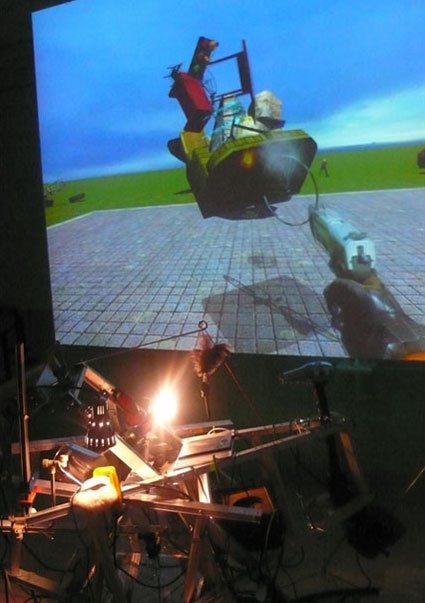http://arttorrents.blogspot.com/
This great blog shows descriptions and stills of artists' films, which are hosted on karagarga.net. Because of copyright-restrictions, karagarga is only accessible for registred users. Some of the videos can also be seen on ubuweb.
If you google for karagarga, you will see this note on the bottom of the page:
"Infolge einer Beschwerde, die hinsichtlich des US Digital Millennium Copyright Act (amerikanisches Datenschutzgesetz) bei uns eingegangen ist, haben wir 1 Ergebnis(se) aus dieser Seite entfernt. Sie können die DMCA-Beschwerde, die dieser Entfernung zugrunde liegt, unter ChillingEffects.org lesen."
On the blog you will find an email-tab and you can write to the authors and ask for a karagarga-invitation. In a forum (http://freakyflicks.proboards54.com/index.cgi?board=chat&action=display&thread=1591&page=3), it says you should answer the following questions:
a. How did you hear about karagarga? Be as specific as possible.
b. What are your favourite movies? List some specific ones. How about books, albums and artists?
c. What do you have to offer for our community?
d. What kind of material are you looking for?
e. Do you know how ratio-based trackers work?
f. Are you connectable?
g. Which other private trackers are you on?
h. Tell us a bit about yourself.
Karagarga has its own forum: http://forum.karagarga.net
You have to register to contribute
Sunday, June 29, 2008
Saturday, June 28, 2008
Lilian Schwartz - The Artist and the Computer
documentary in two parts:
Sten Vanderbeek presents Beflix (written by Ken Knowlton)
Sten Vanderbeek + Beflix
early new media videos
I have collected some videos on youtube that deal with early new media art and develpoments, you can either watch them here or go to: http://uk.youtube.com/view_play_list?p=03BB467DF23B962B
Labels:
Media Art Histories,
videos
Niklas Luhmann explains his "Zettelkasten"
(video only in German)
Labels:
tool
Thursday, June 26, 2008
Operating Systems Documentation Project
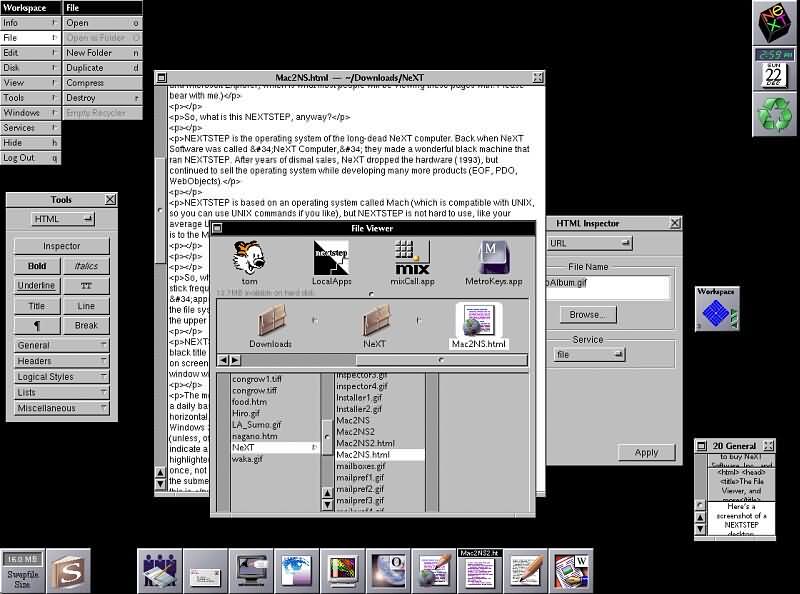
the Operating Systems Documentation Project archives + provides information about various Operating Systems such as many different Linux distributions + flavors, FreeBSD, MacOS, Windows, OS/2, AIX , NEXTSTEP (screenshot above), etc... in Deutsch, English + Français.
Wednesday, June 25, 2008
Vilém Flusser Theory Award
In order to reflect the growing number of theoretical and critical practice works submitted for the competition, the transmediale festival is announcing the creation of the Vilém Flusser theory award.
In collaboration with the recently opened Vilém Flusser Archive at the Universität der Künste in Berlin, dedicated to the complete works of the influential visionary and media philosopher, the prize, endowed with 2,000 euros, honours outstanding theoretical or research based practice.
2008 the international jury awarded a first prize, endowed with 1,000 euros, and and two honourable mentions, endowed with 500 euros each.
The winner of Vilém Flusser Theory Award 2008
The 1. Prize was awarded to Simon Yuill (uk) for his text "All problems of notation will be solved by the masses: Free Open Form Performance, Free/Libre Open Source Software, and Distributive Practice" (2008).
http://www.transmediale.de/site/award/vilem-flusser-award/
In collaboration with the recently opened Vilém Flusser Archive at the Universität der Künste in Berlin, dedicated to the complete works of the influential visionary and media philosopher, the prize, endowed with 2,000 euros, honours outstanding theoretical or research based practice.
2008 the international jury awarded a first prize, endowed with 1,000 euros, and and two honourable mentions, endowed with 500 euros each.
The winner of Vilém Flusser Theory Award 2008
The 1. Prize was awarded to Simon Yuill (uk) for his text "All problems of notation will be solved by the masses: Free Open Form Performance, Free/Libre Open Source Software, and Distributive Practice" (2008).
http://www.transmediale.de/site/award/vilem-flusser-award/
Labels:
competition,
festival,
theory
Monday, June 23, 2008
Media Art in China 2 - Synthetic Times
in addition to the last post:
MIT press just published a catalogue "synthetic times".
essays can be found here: http://www.mediartchina.org/forum
MIT press just published a catalogue "synthetic times".
essays can be found here: http://www.mediartchina.org/forum
Labels:
exhibition,
publication
Sunday, June 22, 2008
Media Art in China reviewed from we make money not art
"Beijing is the hot city for media art this month." this sentence introduces part 1 of Régine Debatty of we make money not art 's review of current Media Art exhibitions + events in China
Thursday, June 19, 2008
James Houston's amazing retro-tech remix of Radiohead's Nude
Big Ideas (don't get any) - James Houston (2008)
http://1o3o.tumblr.com
James Houston's amazing retro-tech remix of Radiohead's Nude track on "a collection of old redundant hardware" uses the following lineup:
"Sinclair ZX Spectrum - Guitars (rhythm & lead)
Epson LX-81 Dot Matrix Printer - Drums
HP Scanjet 3c - Bass Guitar
Hard Drive array - Act as a collection of bad speakers - Vocals & FX"
to create a obsoleted media robot band puppeteered by Houston to perform a fantastically mechanical cover of Radiohead's Nude...

the production still above shows Houston on the film set with the devices. the fact that this 'music video' was filmed on 16mm film makes the mediation of/meditation on these obsoleted media/devices even more wonderful - jonCates
rediscovered + dead (paper-based) media

dead (tree) paper-based + edged-notched card-stacked pre-digital proto-Web medum are the subject of this New York Times article + this Kevin Kelly blog post that have been reblogged by Boing Boing...

the New York Times article describes a system imagined in 1934 by Belgian inventor/visionary Paul Otlet as a global network of hyperlinked "electric telescopes”, telegraphs + paper-based writing/reading/annotation materials as well as exchangeable multimedia devices ("radio-telephones", gramophones, films, "radio-televisions", etc...) + documents. as the article mentions this sounds very Steampunk relative to current experiences but also writes alternative histories/genealogies of the development of the Internet + the Web as Otlet speculated on the future “mechanical, collective brain” containing a comprehensive archive of human knowledge + accessible through an international electromechanical telecommunications network that he called the “réseau”. in the city of Mons in Belgium, a museum, dedicated to the rediscovery of Otlet + his system, the Mundaneum, celebrates it's 10th anniversary today
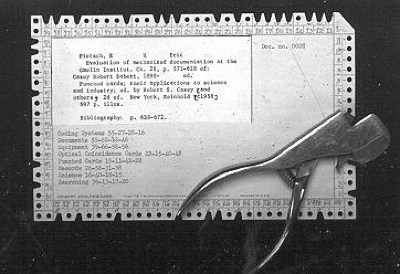
the Kevin Kelly blog post retraces a Media Archeology of a specific paper-based, edged-notched card-stacked system. Kelly details a commercial product called "InDecks Information Retrieval cards" that were obsoleted by commercial computing systems + have since been documented as an entry in Bruce Sterling's Dead Media Project - jonCates
Wednesday, June 18, 2008
jon.satrom resuscitates the Sandin Image Processor
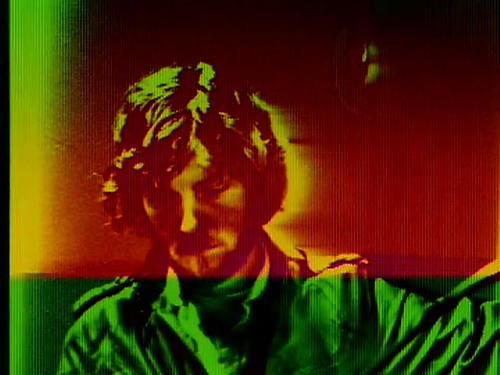
jon.satrom documents his process of resuscitating the Sandin Image Processor for his realtime class @ The School of the Art Institute of Chicago's Film, Video & New Media dept in 2007.
jonCates resuscitates the Sandin Image Processor
jonCates documents his process of resuscitating the Sandin Image Processor for his realtime class @ The School of the Art Institute of Chicago's Film, Video & New Media dept in 2005.
Dan Sandin demonstrates the Sandin Image Processor
Dan Sandin demonstrates the Sandin Image Processor in his "5 Minute Romp Through the IP" video from 1973. The Sandin Image Processor is a general purpose patch-programmable analog computer optimized for video (+ audio) information processing and synthesis developed from 1971 - 1973 by Dan Sandin in Chicago.
In 1973, Phil Morton asked Dan Sandin if he could build the first copy of Sandin's original Sandin Image Processor. Sandin and Morton then began to work together to create the schematic plans for the Sandin Image Processor, a document they called the Distribution Religion. Through The Distribution Religion, Sandin open sourced his Sandin Image Processor, giving the plans away for only the cost of making Xerox copies and mailing them while incorporating any additions or modifications made by those who built their own Sandin Image Processor into any further releases of the Distribution Religion.
Morton developed an approach he called COPY-IT-RIGHT, an anti-copyright approach to making and freely sharing Media Art. The Distribution Religion and Morton's individual and collaborative Media Art works were released under his COPY-IT-RIGHT license. COPY-IT-RIGHT encouraged people to make faithful copies, caring for and distributing the work as widely as possible. - jonCates
Bill Etra demonstrates the Rutt-Etra Video Synthesizer
Bill Etra demonstrates the Rutt-Etra Video Synthesizer in this amazing video. the Rutt-Etra Video Synthesizer was "an analog computer for video raster manipulation." * Etra uses the Synthesizer to manipulate the video signal of this document as he discusses the functionality and abilities of the device during the first 1 + 1/2 of this video. the next 6 minutes feature video signal manipulations set to sounds of experimental electronic musics. the Paik-Abe Video Synthesizer, the Rutt-Etra Video Synthesizer + the Sandin Image Processor were among the first + most widely used systems of their kind that enabled Media Artists to manipulate audio + video signal simultaneously + interdependently in realtime performances as well as in the production of video artworks. - jonCates
* "Rutt-etra Video SynthesizeR - ( 1972)" - AudioVisualizers.com
http://www.audiovisualizers.com/toolshak/vidsynth/ruttetra/ruttetra.htm
Monday, June 16, 2008
evaluations
evaluating scope and content:
when we are evaluating archives of media art, the question is not so much what is included, but what is left out; it is not what the creators themselves tell us about it, but what they are not mentioning that should raise doubt and be a cause for critical investigation.
evaluating methods:
the relation task - method -result
it is not the most important question which methodology you are using and within this method, whose direction you are following or that you are applying someone else's methodology to legitimize your own research. the task itself should legitimize the method and the method should be adequate to deal with the task. looking over the boundaries of a discipline and defining your own set of methods is necessary to deal with media art histories.
a chain of constant, unbroken legitimization only prevents change. it preserves the glory of everyone in that chain. continuity of the chain just makes sure that the gatekeepers keep control and keep themselves and their work historically manifestated, that they will be referenced over and over again and that mankind stays dumb and blindfolded.
when we are evaluating archives of media art, the question is not so much what is included, but what is left out; it is not what the creators themselves tell us about it, but what they are not mentioning that should raise doubt and be a cause for critical investigation.
evaluating methods:
the relation task - method -result
it is not the most important question which methodology you are using and within this method, whose direction you are following or that you are applying someone else's methodology to legitimize your own research. the task itself should legitimize the method and the method should be adequate to deal with the task. looking over the boundaries of a discipline and defining your own set of methods is necessary to deal with media art histories.
a chain of constant, unbroken legitimization only prevents change. it preserves the glory of everyone in that chain. continuity of the chain just makes sure that the gatekeepers keep control and keep themselves and their work historically manifestated, that they will be referenced over and over again and that mankind stays dumb and blindfolded.
Labels:
archive/archiving,
evaluations,
Media Art Histories
Sunday, June 15, 2008
Archiving the Avant-Garde
participants include:
Kevin kelly, Stewart Brand, Jane Metcalfe, Richard Rinehart, Jon Ippolito, Bruce Sterling, Marisa Olsen, Michael Katchen, Alexander Rose, Kurt Bollacker, Jeff Rothenberg
The conference took place at Berkley in January 2007.
The whole symposium can be watched online at http://www.bampfa.berkeley.edu/about/newmedia
Form the website:
The conference is "a public symposium to discuss strategies for peserving digital art at a time when digital technologies are evolving and becoming obsolete at an astonishingly rapid pace. While focussing on digital art, the symposium will also address larger concerns about the long-term conservation of our increasingly digital culture, including how we decide what digital content - from Web sites to video games - are worth saving."
Kevin kelly, Stewart Brand, Jane Metcalfe, Richard Rinehart, Jon Ippolito, Bruce Sterling, Marisa Olsen, Michael Katchen, Alexander Rose, Kurt Bollacker, Jeff Rothenberg
The conference took place at Berkley in January 2007.
The whole symposium can be watched online at http://www.bampfa.berkeley.edu/about/newmedia
Form the website:
The conference is "a public symposium to discuss strategies for peserving digital art at a time when digital technologies are evolving and becoming obsolete at an astonishingly rapid pace. While focussing on digital art, the symposium will also address larger concerns about the long-term conservation of our increasingly digital culture, including how we decide what digital content - from Web sites to video games - are worth saving."
Labels:
archive/archiving,
conference,
media art
Media, Memory and the Archive
Conference on Media Art Archiving, organized by Argos (January 2007)
http://www.argosarts.org/articles.do?id=374
From the website:
"How will generations after us look back on artistic production of the 20th and 21st centuries? Media formats, operating systems, software and hardware, browsers and the internet as we know it today will have evolved beyond recognition, both in shape and in use. What strategies might be used to transpose technology-based works, variable, hybrid and ephemeral by nature, to an unknown and unpredictable future? How can intent, context and experience be recorded and permanently interpreted? The archiving process does not merely represent an attempt to preserve some notions, it also implicates that others will be forgotten. What is relevant for preservation? What is the impact of used models, technical structures and tools on the construction of cultural memory? How does information travel through time, now that the world is being (re)presented and organised more and more as a database, dynamic and networked? How will museums and other memory institutions cope with these new paradigms and what is the role media artists and we ourselves might have in the structuring of public memory?"
participants include Charlie Gere, Josephine Bosma, Oliver Grau, Wolfgang Ernst, Jean-Francois Blanchette, Richard Rinehart and Steve Dietz
The conference took place at Argos in January 2007.
Unfortuantely, there are no audio- or videofiles available on the net.
http://www.argosarts.org/articles.do?id=374
From the website:
"How will generations after us look back on artistic production of the 20th and 21st centuries? Media formats, operating systems, software and hardware, browsers and the internet as we know it today will have evolved beyond recognition, both in shape and in use. What strategies might be used to transpose technology-based works, variable, hybrid and ephemeral by nature, to an unknown and unpredictable future? How can intent, context and experience be recorded and permanently interpreted? The archiving process does not merely represent an attempt to preserve some notions, it also implicates that others will be forgotten. What is relevant for preservation? What is the impact of used models, technical structures and tools on the construction of cultural memory? How does information travel through time, now that the world is being (re)presented and organised more and more as a database, dynamic and networked? How will museums and other memory institutions cope with these new paradigms and what is the role media artists and we ourselves might have in the structuring of public memory?"
participants include Charlie Gere, Josephine Bosma, Oliver Grau, Wolfgang Ernst, Jean-Francois Blanchette, Richard Rinehart and Steve Dietz
The conference took place at Argos in January 2007.
Unfortuantely, there are no audio- or videofiles available on the net.
Friday, June 13, 2008
media/art/archive
http://www.swr.de/medienkunstpreis/archiv/archiv.php?language=e&version=light&autoyear=&autonr=&winners=
ZKM and the boradcast station SWR host an event called the international media art prize every year and now put the material online.
ZKM and the boradcast station SWR host an event called the international media art prize every year and now put the material online.
Labels:
archive/archiving,
media art
Emotoscope as a media archaeological approach...

the Emotoscope by kenichi okada seems to be a project that takes the media archaeological approach of Erkki Huhtamo. As Huhtamo wrote in his 1995 txt Resurrecting the Technological Past, New Media Artists who take media archaeological approaches scan "technocultural forms, moving back and forth in time". the physical form of the Emotoscope + the formation of the media made w/the device both recast the past, but the question remains the extent to which the Emotoscope articulates itself + thereby positions the artist + those behind the camera nostalgically... - jonCates
Emotoscope - kenichi okada (2007)
http://www.kenichiokada.com/projects/2007/emotoscope.html
"Emotoscope is a device that gives you an experience of missing time." - kenichi okada
"Emotoscope, for example, is a sort of portable camera device, which is capable of changing the viewpoint of whomever films, hence presenting the footage under a different light. What actually happens is that Emotoscope playbacks the video in a grainy, silent movie style, casting onto the image a feel of ancient marvelous stories, which are still impressed onto the very minds of the people who experienced them." - Tony Canonico in Neural.it :: media culture, hacktivism
Saturday, June 7, 2008
CARDIAC

short for Cardboard Illustrative Aid to Computing, was a product designed by Bell Labs. It should help to understand the basics of computers and how they operate. The cardboard computer was based on a punched card model.
http://www.boingboing.net/2005/10/20/cardiac-bell-labss-o.html
Labels:
history of computing
Friday, June 6, 2008
the machine that changed the world
a series of five documentaries covering the history of computing, produced by WGBH (PBS) and the British Broadcasting Company (BBC) in the early 90ies and including interviews with Konrad Zuse and Presper Eckert.
http://waxy.org/2008/06/the_machine_that_changed_the_world/
The titles of the five parts:
1 - Great Brains
2 - Inventing the Future
3 - The Paperback Computer
4 - The Thinking Machine
5 - The World at your Fingertips
http://waxy.org/2008/06/the_machine_that_changed_the_world/
The titles of the five parts:
1 - Great Brains
2 - Inventing the Future
3 - The Paperback Computer
4 - The Thinking Machine
5 - The World at your Fingertips
Labels:
history of computing,
video
society of algorithm - timeline of art
Labels:
history,
Media Art Histories,
timeline
Thursday, June 5, 2008
public curating project by cont3xt.net
"PUBLICCURATING is an ongoing research-project by the Vienna-based platform CONT3XT.NET collecting methods, resources, and theories concerning the curation of (New) Media, Internet-based, and Video Art."
take a look at their huge archive on media art history, theory, and methods:
http://publiccurating.cont3xt.net/?tag=theories
take a look at their huge archive on media art history, theory, and methods:
http://publiccurating.cont3xt.net/?tag=theories
Labels:
media art,
Media Art Histories,
theory
CACHe
project by Charlie Gere, Paul Brown et.al.
CACHE hosts archive-material of the Computer Arts Society, such as:
a lot of scans of early computer graphic art of the Computer Arts Society or scans of their PAGE-magazine.

"The CACHe Project is an archive of pioneering British computer art
From 2002 to 2005 CACHe was based at the Vasari Lab in the School of History of Art and Visual Media, Birkbeck, University of London. It digitised and catalogued the image holdings of the Computer Arts Society and several other archives that charted the development of computer-based art in the UK. These archives offer a unique record of the evolution of digital imagery in the 1960s and 1970s.
The core archive of art works collected by the Computer Arts Society has now been acquired by the Victoria and Albert Museum."
http://www.e-x-p.org/cache/CAShistory.htm
CACHE hosts archive-material of the Computer Arts Society, such as:
a lot of scans of early computer graphic art of the Computer Arts Society or scans of their PAGE-magazine.

Georg Nees, 1969
"The CACHe Project is an archive of pioneering British computer art
From 2002 to 2005 CACHe was based at the Vasari Lab in the School of History of Art and Visual Media, Birkbeck, University of London. It digitised and catalogued the image holdings of the Computer Arts Society and several other archives that charted the development of computer-based art in the UK. These archives offer a unique record of the evolution of digital imagery in the 1960s and 1970s.
The core archive of art works collected by the Computer Arts Society has now been acquired by the Victoria and Albert Museum."
http://www.e-x-p.org/cache/CAShistory.htm
Computerkunst
http://www.computerkunst.org/
Website of Christoph Klütsch,
with a timeline of early exhibitions of computer art (http://www.computerkunst.org/exhibitions.html), a bibliography (http://www.computerkunst.org/Lit_early_dig_computerart.html), a linklist to artists' websites and especially: http://www.computerkunst.org/Kluetsch_Art_Metaphysics_2006.pdf
Website of Christoph Klütsch,
with a timeline of early exhibitions of computer art (http://www.computerkunst.org/exhibitions.html), a bibliography (http://www.computerkunst.org/Lit_early_dig_computerart.html), a linklist to artists' websites and especially: http://www.computerkunst.org/Kluetsch_Art_Metaphysics_2006.pdf
Labels:
artists,
bibliography,
Media Art Histories,
publication,
timeline
Wednesday, June 4, 2008
bit international
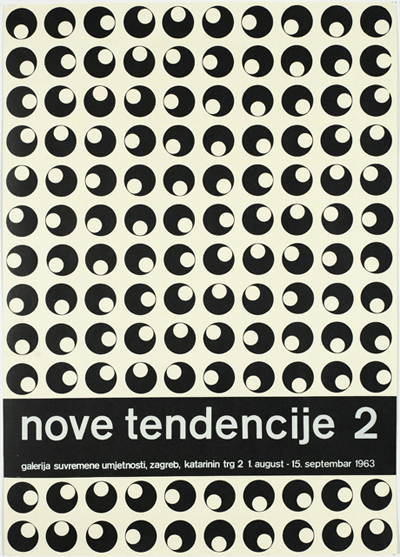 bit international
bit international[Nove] tendencije - Computer
und visuelle Forschung
Zagreb 1961-1973
ZKM, 23.02.2008-22.02.2009
http://www02.zkm.de/bit/
"Mit dieser Ausstellung widmet sich das ZKM | Karlsruhe einer der wichtigsten internationalen künstlerischen Strömungen der 1960er Jahre, den Neuen Tendenzen, und ihrer Bedeutung für die Geschichte der computergestützten Künste. 1968 entschieden sich die Neuen Tendenzen, den Computer als Mittel künstlerischen Arbeitens in ihr Programm aufzunehmen, um so ihren Avantgarde-Anspruch zu behaupten und an der Definition einer Technologie mitzuwirken, von der man vermutete, sie würde die Zukunft der Zivilisation bestimmen. [...]"
Labels:
exhibition,
Media Art Histories
Sunday, June 1, 2008
Early Computer Graphics @ Translab Website
http://translab.burundi.sk/code/vzx/index.htm#9
from the website:
"In the early 1960s digital computers became available to artists for the first time
(although they cost from $100.000 to several millions, required air conditioning, and
therefore located in separate computer rooms, uninhabitable 'studios';
programs and data had to be prepared with the keypunch, punch cards then fed into the computer;
systems were not interactive and could produce only still images).
The output medium was usually a pen plotter, microfilm plotter (hybrid bwn vector CRT
and a raster image device), line printer or an alphanumeric printout, which was then manually
transferred into a visual medium.
from the website:
"In the early 1960s digital computers became available to artists for the first time
(although they cost from $100.000 to several millions, required air conditioning, and
therefore located in separate computer rooms, uninhabitable 'studios';
programs and data had to be prepared with the keypunch, punch cards then fed into the computer;
systems were not interactive and could produce only still images).
The output medium was usually a pen plotter, microfilm plotter (hybrid bwn vector CRT
and a raster image device), line printer or an alphanumeric printout, which was then manually
transferred into a visual medium.
Two main centers of computer art activities:
The Murray Hill lab, Bell Laboratories, New Jersey, us (now AT&T),
Technische Universitat Stuttgart, de (Max Bense)
LIST OF MENTIONED ARTISTS
Ben F Laposky 1952-56
Herbert Franke 1953-55, 1953, 1961-62, 1969 (+ Peter Henne), 1970-71, 1975, 1975, 1978, 1978
William Fetter 1960
A Michael Noll 1962, 1963, 1964, 1964
Charles Csuri 1963, 1968, 1968
Ivan Sutherland 1963
Kenneth Knowlton 1963 (+ Lillian Schwartz), 1964 (+ Stan Vanderbeek), 1966 (+ Leon Harmon)"
John Whitney sr 1963-66, 1967, 1975
Stan Vanderbeek 1964
Frieder Nake 1965
John Stehura 1965-69
Tony Pritchett 1968
Georg Nees 1968-71
Vera Molnar 1968-69, 1974
Edward Zajec 1969-70, 19691971
Manfred Mohr 1969, 1974-76, 1977, 1978
Mark Wilson 1973
Joan Truckenbrod 1975
Tony Longson 1975, 1978
Labels:
computer graphics,
history,
Media Art Histories
Re:live CFP
MEDIA ART HISTORY 09
Re:live
Third International Conference on the Histories of Media Art, Science and
Technology
Melbourne 26-29 November 2009
Call For Papers – Deadline 19th December 2008
http://www.mediaarthistory.org
Sponsored by Leonardo and the Victorian College of the Arts (University of
Melbourne)
Following the success of Media Art History 05 Re:fresh in Banff and Media
Art History 07 Re:place in Berlin, Media Art History 09 Re:llve in Melbourne
will host three days of keynotes, panels and poster sessions Media Art
History 09 - Re:live, a refereed conference, is calling for papers, panels
and posters on the histories of digital, electronic and technological media
arts. With the theme of Re:live we are especially interested in expanding
the range of topics to include sustainability, live arts and the
technological arts of life, both organic and nonorganic.
How do the media arts change? Through innovation, accident, discovery,
mutation or crisis? How did contemporary media arts come to look and sound
like they do? What options and potentialities and eccentricities in the
history of media have been lost or overlooked or suppressed? What hopes have
been realised and which dashed? What is the history of speculation on
alternate histories, and how have they altered the course of media art
history?
Participants are asked to address at least one the following areas in their
abstract:
- histories of the art-science-technology connection in particular works,
careers, exhibitions and institutions, especially in national and regional
perspective
- histories of biology, the life sciences and bioart in relation to media
arts
- histories of the environment, environmental sciences, ideas of
sustainability and ecology in the discourses and practices of media arts
- histories of liveness and performance in relation to media arts theory and
practice, including network performance, multimedia performance and the
relation of media to the histories of theatre
- histories of the life of machines, cyborgs, virtual communities and the
arts of transmission
- histories of the liveness of real-time arts and art-science-technology
collaborations in such areas as earth sciences, meteorology and astronomy
- histories of innovation, accident, discovery, and speculation on
alternative futures in media arts
We particularly wish to encourage presentations from and about these
histories in the Asia-Pacific region. Proposals are welcomed from artists,
curators, arts organisers and researchers in media, art history, performance
studies, literature, film, and science and technology studies.
Selected papers from the conference will be published in Leonardo (MIT
Press). We are negotiating with academic presses for one or two anthologies
from the conference.
Submissions: A dedicated website with updates and online paper submission
system is available at http://www.mediaarthistory.org. Abstracts of
proposals, panel presentations and posters should be submitted in either
text, RTF, PDF or Word formats
Deadline for 200 word abstracts: 19th December 2008.
Please submit proposals at:
http://moodle.donau-uni.ac.at/relive/openconf.php
Sean Cubitt and Paul Thomas, conference co-chairs.
Prof Sean Cubitt
scubitt@unimelb.edu.au
Director, Media and Communications Program
Faculty of Arts
Room 127 John Medley East
The University of Melbourne
Parkville VIC 3010
Australia
Tel: + 61 3 8344 3667
Fax:+ 61 3 8344 5494
M: 0448 304 004
Skype: seancubitt
http://www.culture-communication.unimelb.edu.au/media-communications/
http://homepage.mac.com/waikatoscreen/seanc/
http://seancubitt.blogspot.com/
http://del.icio.us/seancubitt
Editor-in-Chief Leonardo Book Series
http://leonardo.info
Re:live
Third International Conference on the Histories of Media Art, Science and
Technology
Melbourne 26-29 November 2009
Call For Papers – Deadline 19th December 2008
http://www.mediaarthistory.org
Sponsored by Leonardo and the Victorian College of the Arts (University of
Melbourne)
Following the success of Media Art History 05 Re:fresh in Banff and Media
Art History 07 Re:place in Berlin, Media Art History 09 Re:llve in Melbourne
will host three days of keynotes, panels and poster sessions Media Art
History 09 - Re:live, a refereed conference, is calling for papers, panels
and posters on the histories of digital, electronic and technological media
arts. With the theme of Re:live we are especially interested in expanding
the range of topics to include sustainability, live arts and the
technological arts of life, both organic and nonorganic.
How do the media arts change? Through innovation, accident, discovery,
mutation or crisis? How did contemporary media arts come to look and sound
like they do? What options and potentialities and eccentricities in the
history of media have been lost or overlooked or suppressed? What hopes have
been realised and which dashed? What is the history of speculation on
alternate histories, and how have they altered the course of media art
history?
Participants are asked to address at least one the following areas in their
abstract:
- histories of the art-science-technology connection in particular works,
careers, exhibitions and institutions, especially in national and regional
perspective
- histories of biology, the life sciences and bioart in relation to media
arts
- histories of the environment, environmental sciences, ideas of
sustainability and ecology in the discourses and practices of media arts
- histories of liveness and performance in relation to media arts theory and
practice, including network performance, multimedia performance and the
relation of media to the histories of theatre
- histories of the life of machines, cyborgs, virtual communities and the
arts of transmission
- histories of the liveness of real-time arts and art-science-technology
collaborations in such areas as earth sciences, meteorology and astronomy
- histories of innovation, accident, discovery, and speculation on
alternative futures in media arts
We particularly wish to encourage presentations from and about these
histories in the Asia-Pacific region. Proposals are welcomed from artists,
curators, arts organisers and researchers in media, art history, performance
studies, literature, film, and science and technology studies.
Selected papers from the conference will be published in Leonardo (MIT
Press). We are negotiating with academic presses for one or two anthologies
from the conference.
Submissions: A dedicated website with updates and online paper submission
system is available at http://www.mediaarthistory.org. Abstracts of
proposals, panel presentations and posters should be submitted in either
text, RTF, PDF or Word formats
Deadline for 200 word abstracts: 19th December 2008.
Please submit proposals at:
http://moodle.donau-uni.ac.at/relive/openconf.php
Sean Cubitt and Paul Thomas, conference co-chairs.
Prof Sean Cubitt
scubitt@unimelb.edu.au
Director, Media and Communications Program
Faculty of Arts
Room 127 John Medley East
The University of Melbourne
Parkville VIC 3010
Australia
Tel: + 61 3 8344 3667
Fax:+ 61 3 8344 5494
M: 0448 304 004
Skype: seancubitt
http://www.culture-communication.unimelb.edu.au/media-communications/
http://homepage.mac.com/waikatoscreen/seanc/
http://seancubitt.blogspot.com/
http://del.icio.us/seancubitt
Editor-in-Chief Leonardo Book Series
http://leonardo.info
Labels:
announcement,
conference,
Media Art Histories
Subscribe to:
Comments (Atom)
